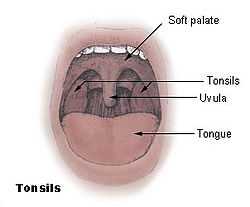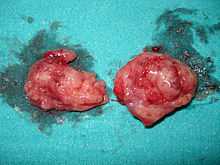Tonsil
- For the structure in the cerebellum, see cerebellar tonsil.

Tonsils are collections of lymphoid tissue[1] facing into the aerodigestive tract. The set of lymphatic tissue known as Waldeyer's tonsillar ring includes the adenoid tonsil, two tubal tonsils, two palatine tonsils, and the lingual tonsil.
When used unqualified, the term most commonly refers specifically to the palatine tonsils, which are masses of lymphatic material situated at either side at the back of the human throat. The palatine tonsils and the nasopharyngeal tonsil are lymphoepithelial tissues located near the oropharynx and nasopharynx (parts of the throat). These immunocompetent tissues are the immune system's first line of defense against ingested or inhaled foreign pathogens. However, the fundamental immunological roles of tonsils have yet to be understood.[2][3]
Tonsils tend to reach their largest size near puberty, and they gradually undergo atrophy thereafter. However, they are largest relative to the diameter of the throat in young children.
Tonsils in humans include, from anterior (front), superior (top), posterior (back), and inferior (bottom):
| Type | Epithelium | capsule | Crypts | Location |
|---|---|---|---|---|
| Adenoids (also termed "pharyngeal tonsils") | Ciliated pseudostratified columnar (respiratory epithelium) | Incompletely encapsulated | No | Roof of pharynx |
| Tubal tonsils | Ciliated pseudostratified columnar (respiratory epithelium) | Roof of pharynx | ||
| Palatine tonsils | Non-keratinized stratified squamous | Incompletely encapsulated | Long, branched[4] | Sides of oropharynx between palatoglossal and palatopharyngeal arches |
| Lingual tonsils | Non-keratinized stratified squamous | Incompletely encapsulated | Long, unbranched[4] | Behind terminal sulcus (tongue) |
Pathology

Tonsils can become enlarged (adenotonsillar hyperplasia) or inflamed (tonsillitis) and may require surgical removal (tonsillectomy). This may be indicated if they obstruct the airway or interfere with swallowing, or in patients with frequent recurrent tonsillitis. However, different mechanisms of pathogenesis for these two subtypes of tonsillar hypertrophy have been described,[5] and may have different responses to identical therapeutic efforts. In older patients, asymmetric tonsils (also known as asymmetric tonsil hypertrophy) may be an indicator of virally infected tonsils, or tumors such as lymphoma or squamous cell carcinoma.
Tonsillitis is a disorder in which the tonsils are inflamed (sore and swollen). The most common way to treat it is with anti-inflammatory drugs such as ibuprofen, or if bacterial in origin, antibiotics, e.g. amoxicillin and azithromycin. Often severe and/or recurrent tonsillitis is treated by tonsillectomy.[6][7]
A tonsillolith is material that accumulates on the tonsil. They can range up to the size of a peppercorn and are white/cream in color. The main substance is mostly calcium, but they have a strong unpleasant odor because of hydrogen sulfide and methyl mercaptan and other chemicals.[citation needed]
Tonsil enlargement can affect speech, making it hypernasal and giving it the sound of velopharyngeal incompetence.[8] Tonsil size may have a more significant impact on upper airway obstruction for obese children than for those of average weight.[9]
References
- ↑ Stedman's Medical Dictionary entry on Tonsil
- ↑ Journal of the Wakayama Medical Society - [Study on functions of tonsils in mucosal immune system of the upper respiratory tract using a novel animal model, Suncus murinus.] - VOL.52;NO.4;PAGE.361-367(2001)
- ↑ 'Tonsils and adenoids are immune system glands...' [Harvard Medical School Family Health Guide - Page: 1006 ] - 1995
- ↑ 4.0 4.1 Lymphatic system at downstate.edu
- ↑ "Circulating phospholipase-A2 activity in obstructive sleep apnea". International Journal of Pediatric Otorhinolaryngology 76 (4): 471–4. 2012. doi:10.1016/j.ijporl.2011.12.026. PMID 22297210.
- ↑ Udayan K Shah, MD, Associate Professor of Otolaryngology-Head and Neck Surgery, Jefferson Medical College, Thomas Jefferson University; Director, Fellow and Resident Education in Pediatric Otolaryngology, Attending Surgeon, Division of Otolaryngology, Nemours-AI duPont Hospital for Children
- ↑ Tonsils and Adenoids
- ↑ Mora R, Jankowska B, Mora F, Crippa B, Dellepiane M, Salami A. (2009). Effects of tonsillectomy on speech and voice. J Voice. 23(5) 614-8. doi:10.1016/j.jvoice.2008.01.008 PMID 18468843
- ↑ Wang, JH; Chung, YS, Cho, YW, Kim, DY, Yi, JS, Bae, JS, Shim, MJ (April 2010). "Palatine tonsil size in obese, overweight, and normal-weight children with sleep-disordered breathing". Otolaryngology--head and neck surgery : official journal of American Academy of Otolaryngology-Head and Neck Surgery 142 (4): 516–9. doi:10.1016/j.otohns.2010.01.013. PMID 20304270.
Additional images
-

Illustration of sagittal view of tonsils and throat anatomy.
-

Illustration of frontal view of tonsils.
External links
| Wikimedia Commons has media related to Tonsils. |
| |||||||||||||||||||||||||||||||||